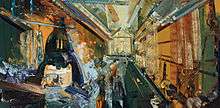David Brewster (painter)



David Brewster (born 1960) is an American painter active in the Mid-Atlantic and Northeastern United States. He’s represented by Walter Wickiser Gallery, New York, NY; Gross McCleaf Gallery, Philadelphia, PA; and C. Grimaldis Gallery, Baltimore, MD.[1]
Early Life and Education
Brewster was born in Baltimore, Maryland and grew up on a farm in nearby Glyndon. His father was an investment banker and his mother worked at the Baltimore Museum of Art as a docent. Both parents were avid equestrians.
He studied at the Pennsylvania Academy of the Fine Arts in Philadelphia (1979–80) and the Leo Marchutz School of Painting and Drawing in Aix-en-Provence, France (1980–82), patterned on Oscar Kokoschka’s “School of Seeing” in Salzburg, Austria. He received a BFA from the Maryland Institute College of Art in Baltimore, MD (1985) and his MFA from the University of Pennsylvania in Philadelphia, PA (1988) where he studied with painter Neil Welliver.[2]
Career
Brewster often paints directly from the subject, creating works in a single pass in the spirit of the American Action painters of the mid 20th century. “He sits within a tradition the French call premier coup,” writes artist Stuart Shils,” meaning ‘all at once,’ an attitude toward work in which the graphic urgency of improvisation response underscores all decisions and informs the energy of the mark making.”[3] Mostly utilizing a variety of rollers to apply paint to canvas, Brewster opts for a brash, acid palette and aggressively works the surface with broad strokes of pigment.[4] Poet and art critic Gerrit Henry writes that “the trick to Brewster, as it was indeed with the Abstract Expressionists, is this very painterly romanticism, called up from psychic depths and executed with an overwhelming conviction.”[5]
Brewster’s work references agriculture, urban landscapes, and commercial development, and often their decline and abandonment. Author Pamela Mandell writes that his paintings “upend the viewer’s expectations of the pastoral landscape through a startling combination of rural subject matter... with the industrial artifacts of contemporary life.”[6] Writer Edward Lucie-Smith describes Brewster’s work as “a record of one man’s exhilarated dialogue with the natural world, and his spontaneous record of his own presence within it — they do not freeze a moment, but instead speak of a state of continuous psychic evolution.”[7]
Brewster has been a visiting artist and critic at Maryland Institute College of Art, Baltimore, MD (2013); Pennsylvania Academy of the Fine Arts in Philadelphia, PA (2013); Towson University in Baltimore, MD (2013) and at Marlboro College in Marlboro, VT (2009). He taught painting at the Pomfret School in Pomfret, CT (1995-2000); at Deerfield Academy in Deerfield, MA (2003-2005); and at Milton Academy in Milton, MA (2007-2008). He was a teacher in residence at Deep Springs College (high desert of Eastern CA) both in 2003 and in 2006.
Brewster has had more than twenty-five solo exhibitions, and has participated in over thirty group shows, including the Philadelphia Museum of Art (1994), the Currier Museum of Art (2000), Musée Granet (2000), McMullen Museum of Art (2003), Berman Museum of Art (2004), and the Pennsylvania Academy of the Fine Arts (2013). The Maryland Historical Society in Baltimore, Maryland will present a retrospective of Brewster’s work in 2015.
Brewster is represented in private and museum collections including the Berman Museum of Art, Pennsylvania Academy of Fine Arts, Johns Hopkins Carey Business School, Vermont State House, Princeton University Art Museum, The State Museum of Pennsylvania and the Wharton School of the University of Pennsylvania at the University of Pennsylvania. He has received numerous awards including the Pollock-Krasner and Berkshire Taconic Foundation Grants.
References
- ↑ Contemporary Philadelphia Artists, p. 93,138. Philadelphia Museum of Art, Philadelphia, PA, 1990.
- ↑ U.S. Ambassador’s Residence, Dublin, Ireland,p. 16. Art in Embassies Program, United States Department of State, Washington, D.C. 2004.
- ↑ Stuart Shils, "The Glorious Wake of that Painter's Visual Joy,": p. 16-19. Joseph Wharton, 1826-1909: Ironmaster, Innovator and Educator, 2012.
- ↑ Sozanski, Edward J., “His Landscapes Are Not Nostalgic Trips.” The Philadelphia Inquirer, December 21, 2003.
- ↑ Gerrit Henry. "David Brewster at Spheris,", p. 153. Art in America, September 2000.
- ↑ Mandell, Pamela, “Haunted Places and Unsettling Landscapes,” p. 6, 14. Art New England, June/July 2008.
- ↑ Edward Lucie-Smith. "David Brewster — Irrespressible Storm," p. 2. Walter Wickiser Gallery, 2008.